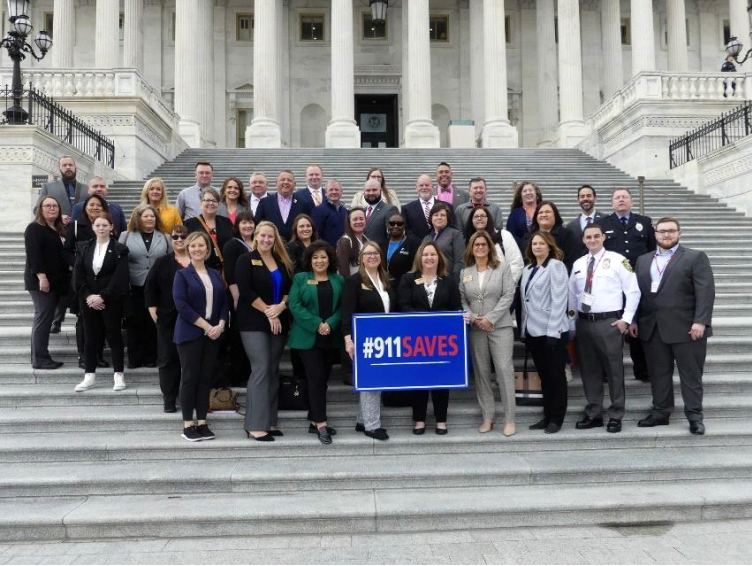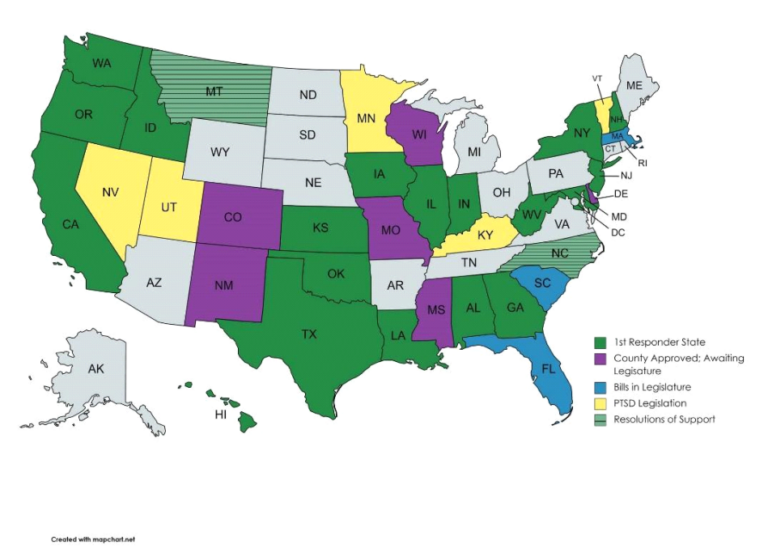
As 911 professionals, we often feel helpless in the pursuit of the “big” goals. The goals that seem so audacious that there is no clear path forward. We feel overwhelmed as we sit in our centers or in our offices feeling small, like we are unable to make a difference. We think, well I cannot do it all, so there is nothing I can do. But to quote Glennon Doyle, “I will not let the fact that I cannot do everything keep me from doing what I can.” It is in this spirit that I challenge you to take action. Because each of you hold the keys to lead the industry to the classification of 911 professionals as first responders! Not sure where to start?; please read on.
If a goal without a plan is just a dream, until recently many of us have been trying to dream reclassification into being. Incremental progress has been made across the nation, at local and state levels through detailed planning, intentional work, and a bit of blood, sweat and tears. The step that takes us from dreaming to doing is planning, creating a roadmap that allows centers, counties, states, and the nation to take deliberate steps toward reclassification. And the only way to create those steps is through education and action. So let’s start with a bit of education on what’s happening on the reclassification front today.
I like to think of reclassification as three different approaches: (1) the Bureau of Labor Statistics– a bureau within the Department of Labor that “provides statistical guidance to the department and its agencies and works in partnership with those agencies to support their data needs.” [1] (2) The 911 SAVES Act, and (3) statewide efforts. Each of these efforts attempt to tackle reclassification from different angles. Let’s break this down.
The Bureau of Labor Statistics (BLS)
If you read one part of this article, make it this part. Here’s where the opportunity for action falls largely, and specifically on the 911 professionals. Put simply, the BLS is required to classify jobs based on objective, measurable data. There are 867 occupations in which the BLS can classify a specific job, and they review their classifications every eight – ten years. It’s worth repeating, the BLS bases its classification decisions on objective, measurable data. This is not because the folks at the BLS don’t care how difficult and nuanced the job of a telecommunicator is, it’s because they are required by law to use specific measurements and data.
In 2018, the BLS classified 911 telecommunicators as an “Office and Administrative Support Occupation”, a clerical classification. This was not for lack of trying. The 911 community came together and submitted information to the BLS, it just wasn’t the objective, measurable data that they needed to change this classification.
In a recent article on 911derWomen.com, Board of Directors Chair, Laurie Flaherty breaks down the BLS decision like this:
- “BLS randomly collected 1,000 PST job descriptions. The majority of these documents described PST work as clerical; and many of the job descriptions were older than the PSTs in those jobs.
- While BLS received input from thousands of 911 advocates, most of the input received was opinion without tangible proof.” [2]
Here’s where you come in. The process for updating the classifications usually starts three – four years before the BLS publishes a new revision.[3] There are opportunities for public input, and that time is fast approaching. We need to act now if we are going to be ready.
Get Informed – Because of the feedback we received from BLS last time around, we now know that there is “low hanging fruit” we can grab at to give us the best chance of reclassification. If 911 wants to be recognized as first responders, we must show (on paper) how complex and critical the job of a telecommunicator is today. We do that by updating the following:
- Job descriptions
- Training documentation
- Policies and procedures
Make a Plan – Be the voice in your center. Whether you’re a leader or a squeaky wheel, we put our best reclassification foot forward by completing these tasks. Take ownership of them or assign ownership to them. Borrow from your neighbors that have awesome job descriptions. Go online and search for centers with excellent training. Utilize the resources linked in this article as tools to update your policies and procedures. Having read this bog, you are armed with information, action and planning to take that first step.
Take Action – It is up to YOU to update these documents. Whether you are a director, deputy director, supervisor, frontline or administration, you have a role and resources exist to help you get started and guide you through the process. The National 911 Program, together with the 911 community, has developed a Public Safety Telecommunicator Reclassification toolkit designed to help you through this process.
- Part 1: Developing a Public Safety Telecommunicator Job Description
- This document will show you how to review your current job duties, align job descriptions with operations, and more.
- Part 2: Establishing or Expanding a Public Safety Telecommunicator Training Program
- This document will teach you about training documentation, conducting self-assessments, review your current training and make needed changes.
- Part 3: The Operational Integration of Technology and Tool
- This document teaches you about specific requirements and laws, connecting with stakeholders, working with your neighboring jurisdictions, and writing policies and procedures that help your center manage the huge amount of technology that is being developed.
You are not alone! Not only will these resources prepare your center when the BLS collects the next round of data, but it will help you to elevate your center and your profession at the same time.
The 911 SAVES Act
The Supporting Accurate Views of Emergency Services Act (911 SAVES Act) is a bill that requires the Office of Management and Budget to categorize public safety telecommunicators as a protective service occupation which is the category that currently houses law-enforcement, fire, and other first responders. Re-introduced to the U.S. Congress in 2021, this act was dropped from the legislation, therefore, has not come to fruition. There has been a huge push by the 911 community to write letters to their representatives detailing the intensity and struggles of this critical job, but so far has not been successful.
Here’s what you can do:
Get Informed – You can read the 911 SAVES Act here.
Make a Plan – Chances are there are folks in your state who have an organized effort. Once you find them, learn about their plan and how you can do your part.
Take Action – Find a contact in your state or jurisdiction who can point you in the right direction here.

911 Professionals at NENA’s 911 Goes to Washington in 2023
Statewide Reclassification Efforts
There have been several states across the nation who have succeeded at passing reclassification legislation in their state. This means that while telecommunicators are not recognized federally as first responders, they are in those particular states. This change in classification takes on a different meaning in every state, but the precedent has been set and state leaders in 911 continue to fight for state-level reclassification. The map below, updated in February 2023, details state and county level reclassification efforts across the country.[4]

Here’s what you can do:
- Get Informed – There are resources out there that can help! The National 911 Program has a variety of resources available. Developing an Advocacy Strategy for Proper Classification is an incredible tool that will teach you how to:
- Understand your goals and communications plan
- Involve working groups from 911 stakeholders in your state
- Help local decisions-makers understand 911
- Create a media plan and showcase positive 911 stories
- Learn the legislative process and research other state’s bills
- Make a Plan – Utilize the lessons learned from other states and the steps detailed in Advocacy Strategy for Proper Classification toolkit to construct your plan of action. Document your plan, coordinate your plan, and find champions for your plan.
- Take Action – Reach out to your state 911 office, NENA or APCO chapter, or a leader in 911 in your state to see what you can do. Every state is different in terms of laws and strategy, but there is much work to be done and plenty of tasks to go around.
Let’s Do This
This article is a call to action. If you’ve been feeling like you don’t know where to start, start here. Start with reading this article and think about what step you can take next. Start with something you can control, like the job descriptions in your center. If you have the authority to update them, pull them up and take a look. If you don’t have the authority, bring the tools outlined in this article to the person who has authority. Make these tasks projects in your center. Once you take that first step, the next steps will become more clear. We must use the lessons we’ve learned from past reclassification efforts to inform what we do today. Reclassification is up to us. It is up to you. You hold the keys, what are you going to do next?
[1] U.S. Bureau of Labor Statistics, https://www.bls.gov/bls/faqs.htm, accessed 3/8/23
[2]Laurie Flaherty, “Are You Ready to be Reclassified?”, 911der Women, 03/07/2023, 911derwomen.com
[3] U.S. Bureau of Labor Statistics Standard Occupational Classification System, “2018 Standard Occupational Classification System,” 2018 SOC Revision Process, https://www.bls.gov/soc/2018/home.htm, accessed 3/3/23
[4] Rebekah McAleese, Dispatchers as Part of 1st Responders Facebook Page, https://www.facebook.com/groups/reclassify911dispatchers, accessed 3/8/2023